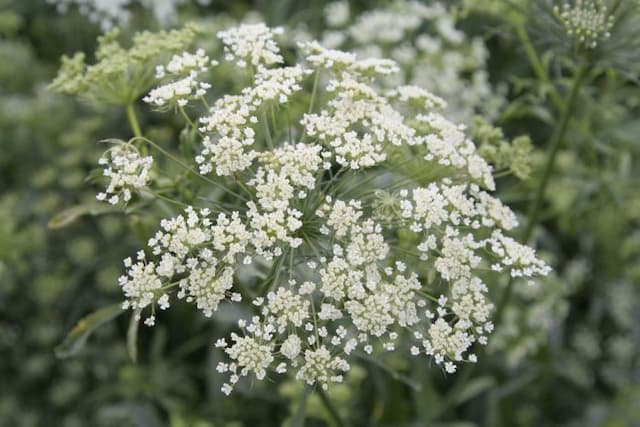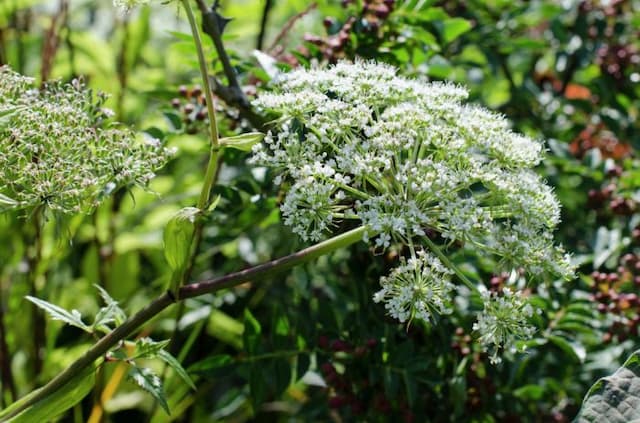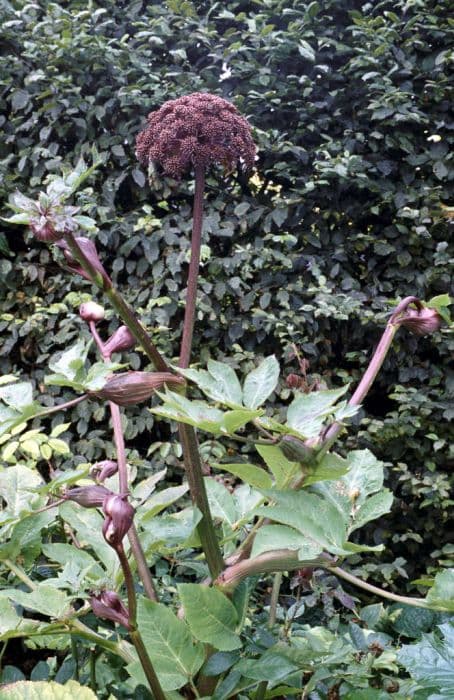Masterwort Astrantia major 'Rosa Lee'

ABOUT
The Rosa Lee Masterwort is a charming perennial plant known for its unique and intricate flowers. The blossoms of this plant are a captivating blend of deep pink and soft purple hues, creating a pincushion-like appearance that is surrounded by a ruff of bracts in a similar shade, giving it a distinctive and appealing look. The bracts are often a paler color, which contrasts elegantly with the darker tones of the central florets. The leaves of the Rosa Lee Masterwort are deeply lobed, resembling an open hand, and present a lush green backdrop for the ornate flowers. The flowering stems rise gracefully above the foliage, holding the complex blooms aloft for an extended period, which makes this plant a favorite among gardeners for its enduring visual interest. The blossoms also attract a variety of pollinators, adding a dynamic element to its presentation in the garden. Blooming typically occurs in the summertime, when the garden is awash with color and life. Additionally, the Rosa Lee Masterwort's cut flowers are highly valued for their exceptional longevity and are a splendid addition to floral arrangements. The overall appearance of the plant elicits a cottage garden feel and lends itself to creating a romantic and whimsical landscape aesthetic.
About this plant
 Names
NamesFamily
Apiaceae
Synonyms
Great Masterwort, Hattie's Pincushion, Melancholy Gentleman
Common names
Astrantia major 'Rosa Lee'.
 Toxicity
ToxicityTo humans
The common name for Astrantia major 'Rosa Lee' is Masterwort. Masterwort is not commonly known as a toxic plant to humans. There is limited information suggesting that any part of this plant, when ingested, causes poisoning in humans. Therefore, it is not generally associated with toxic symptoms or consequences upon ingestion.
To pets
For Masterwort, which is the common name of Astrantia major 'Rosa Lee', there is no specific evidence or reports stating that the plant is toxic to pets. Therefore, it is not widely recognized as a poisonous plant for animals such as dogs and cats, and there are no well-documented symptoms of poisoning from ingesting any part of this plant for pets. However, it's always prudent to keep an eye on pets when they are around plants, as individual animals may have different sensitivities or allergic reactions.
 Characteristics
CharacteristicsLife cycle
Perennials
Foliage type
Deciduous
Color of leaves
Green
Flower color
Pink
Height
2 feet (60 cm)
Spread
1 foot (30 cm)
Plant type
Herb
Hardiness zones
5
Native area
Europe
Benefits
 General Benefits
General Benefits- Attracts pollinators: Astrantia major 'Rosa Lee', also known as Masterwort, is highly attractive to bees and butterflies which help in pollination.
- Ornamental value: With its unique pincushion-like flowers and rosy-pink hue, it adds visual interest to gardens.
- Drought resistance: Once established, it can tolerate periods of drought, making it a low-maintenance choice for gardens.
- Long blooming season: It has a prolonged flowering period from early summer into fall, providing color for an extended time.
- Deer and rabbit resistant: Less likely to be eaten by deer and rabbits, which can help ensure its survival and reduce the need for pest control.
- Versatile in landscape use: Suitable for borders, cottage gardens, and underplanting beneath shrubs and trees.
- Good cut flowers: The blooms are long-lasting in vases, making them excellent for cut flower arrangements.
 Medical Properties
Medical PropertiesThis plant is not used for medical purposes.
 Air-purifying Qualities
Air-purifying QualitiesThis plant is not specifically known for air purifying qualities.
 Other Uses
Other Uses- Dye Production: The roots of Astrantia can be used to produce natural dyes for textiles, providing a range of colors from blacks to reds.
- Art and Craft: Pressed flowers of the Great Masterwort are used in scrapbooking and other paper crafts for their intricate star-like shapes.
- Culinary Garnish: The flowers of Great Masterwort can be used as a garnish for salads and desserts due to their unique appearance.
- Photography: Because of its aesthetic appeal, Great Masterwort is often used as a subject in botanical photography.
- Education: The plant is used in botanical studies to teach about umbel inflorescences and plant morphology.
- Garden Design: Astrantia is used in moon gardens where its flowers are known to catch the moonlight enchantingly.
- Flower Language: In the language of flowers, Great Masterwort signifies courage and strength and can be used in bouquets that wish to convey this message.
- Floral Water: The scent of Great Masterwort flowers can be infused into water to create a light, fragrant floral water for freshening linens.
- Companion Planting: Great Masterwort can be planted alongside vegetables to attract beneficial insects that help with pollination.
- Economic Crop: While less common, some specialty growers may cultivate Astrantia for the florist’s market where its unique blossoms command a higher price.
Interesting Facts
 Feng Shui
Feng ShuiMasterwort is not used in Feng Shui practice.
 Zodiac Sign Compitability
Zodiac Sign CompitabilityMasterwort is not used in astrology practice.
 Plant Symbolism
Plant Symbolism- Mystery: Astrantia major, commonly known as Masterwort, has a detailed and intricate flower structure that suggests complexity and mystery.
- Protection: Historically, Masterwort was used medicinally to ward off various ailments, which contributes to its symbolization of protection.
- Perseverance: The durability of Masterwort and its ability to thrive in various conditions embodies the quality of perseverance and tenacity.
- Strength: Its robust and hardy nature allows Masterwort to symbolize strength.
- Beauty: The unique aesthetic of the Masterwort blooms represents a quiet beauty that does not demand attention but is appreciated upon closer inspection.
 Water
WaterMasterwort prefers consistently moist soil, so it's important to water it regularly. During the growing season, water enough to soak the soil deeply, which often translates to about 1 inch of water per week, either from rainfall or manual watering. In the absence of rain, you may need to water once or twice a week, depending on the weather conditions. When temperatures are extremely hot, Masterwort may require more frequent watering. Always check the top inch of the soil for dryness and water accordingly, avoiding overhead watering to prevent leaf diseases.
 Light
LightMasterwort thrives best in partial shade to full sun. The ideal location for Masterwort would be a spot that receives morning sun and dappled shade in the afternoon to protect it from the intense heat of the day, especially in warmer climates. However, it can also tolerate full sun in cooler, northern regions as long as it receives ample moisture.
 Temperature
TemperatureMasterwort performs well in a wide range of temperatures, but it prefers cooler conditions. It can generally survive in temperatures as low as 0 Fahrenheit but the ideal growing conditions are between 60 and 70 Fahrenheit. Prolonged exposure to temperatures above 85 Fahrenheit can stress the plant, so providing some shade during the hottest part of the day is beneficial.
 Pruning
PruningPruning Masterwort encourages new growth and extends blooming. Deadhead spent flowers regularly to promote continuous blooming throughout the season. In the fall or early spring, cut back the plant's foliage to the ground to maintain a tidy appearance and facilitate healthy new growth. Pruning is typically done after the flowering period subsides or in early spring before new growth starts.
 Cleaning
CleaningAs needed
 Soil
SoilMasterwort, Astrantia major 'Rosa Lee', thrives in moist, well-drained soil enriched with organic matter, with an ideal pH range of 5.5 to 7.0. A good mix might include loamy garden soil, compost, and peat moss to enhance fertility and drainage.
 Repotting
RepottingMasterwort generally does not require frequent repotting; doing so every 2-3 years or when it appears to be root-bound is sufficient to maintain its health.
 Humidity & Misting
Humidity & MistingMasterwort is adaptable to a wide range of humidity levels but prefers average to high humidity similar to its natural woodland habitat.
 Suitable locations
Suitable locationsIndoor
Place Masterwort in bright, indirect light and maintain moist soil.
Outdoor
Plant Masterwort in partial shade, ensure soil is moist and rich.
Hardiness zone
4-7 USDA
 Life cycle
Life cycleGreat Masterwort 'Rosa Lee' begins its lifecycle as a seed which germinates in early spring, preferably in moist, well-drained soil with partial to full sun exposure. Upon germination, the seedling emerges and develops into a basal rosette of deeply lobed, dark green leaves. As it matures during the spring and early summer, a flower stalk arises from the rosette, sporting the plant's distinctive pincushion-like blooms that are pink to purple in color, surrounded by a ruff of bracts. After flowering, typically from June to August, the plant sets seed which can be dispersed by wind or wildlife. In the fall, the above-ground foliage dies back with the onset of colder temperatures, while the roots remain dormant through winter. With spring's arrival, the plant resumes growth, repeating its cycle, and it may also propagate by division as it forms clumps over time.
 Propogation
PropogationPropogation time
Spring to early summer
Propogation: Astrantia major 'Rosa Lee', commonly known as Masterwort, can be propagated by division, which is the most popular method for this perennial plant. The ideal time to propagate Masterwort by division is in the spring or early autumn when the plant is not in active bloom. To do so, carefully dig up the entire plant, ensuring you have a good amount of the root system. Then, using a sharp spade or knife, divide the plant into smaller sections, each with a section of roots and several shoots. Replant these divisions promptly into well-draining soil at the same depth they were growing before and water them thoroughly. With proper care, the new plants will establish themselves and grow, flowering in the following seasons. Division helps not only to propagate Masterwort but also to rejuvenate older clumps that may become woody or less vigorous over time.









